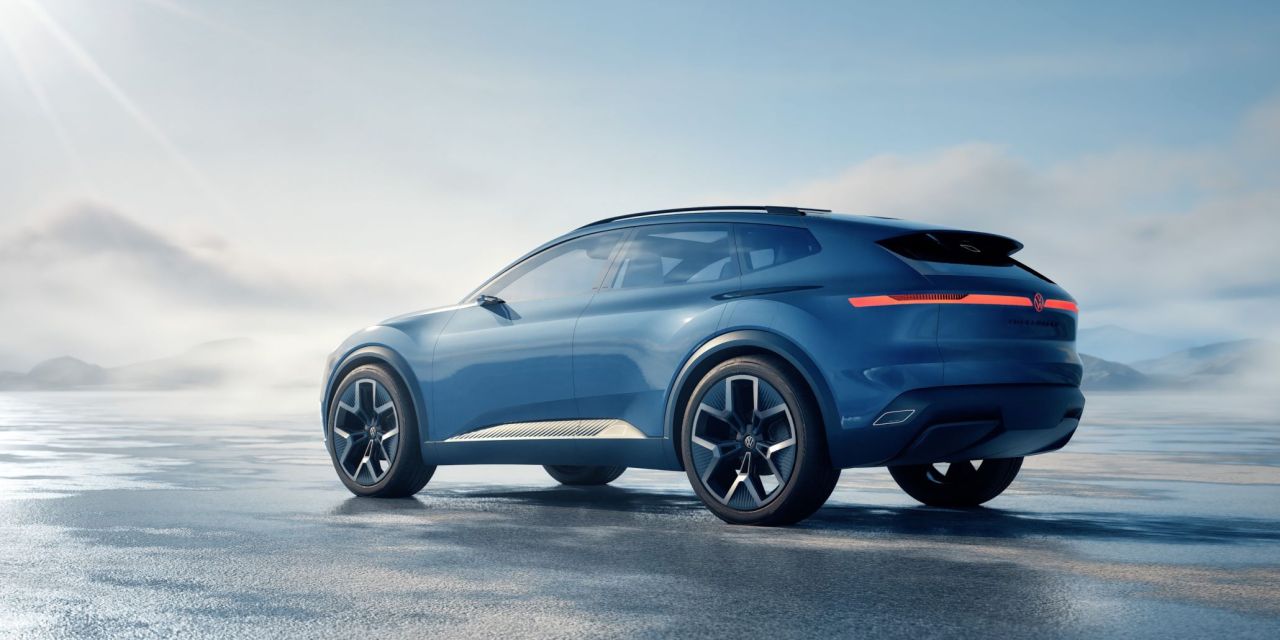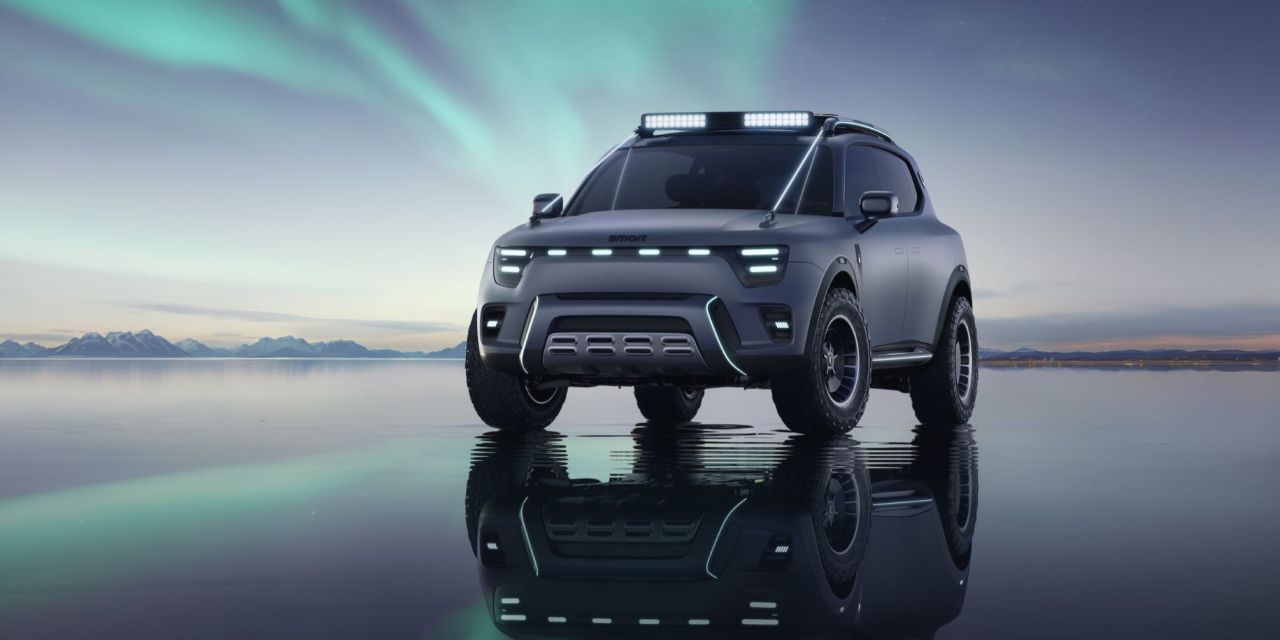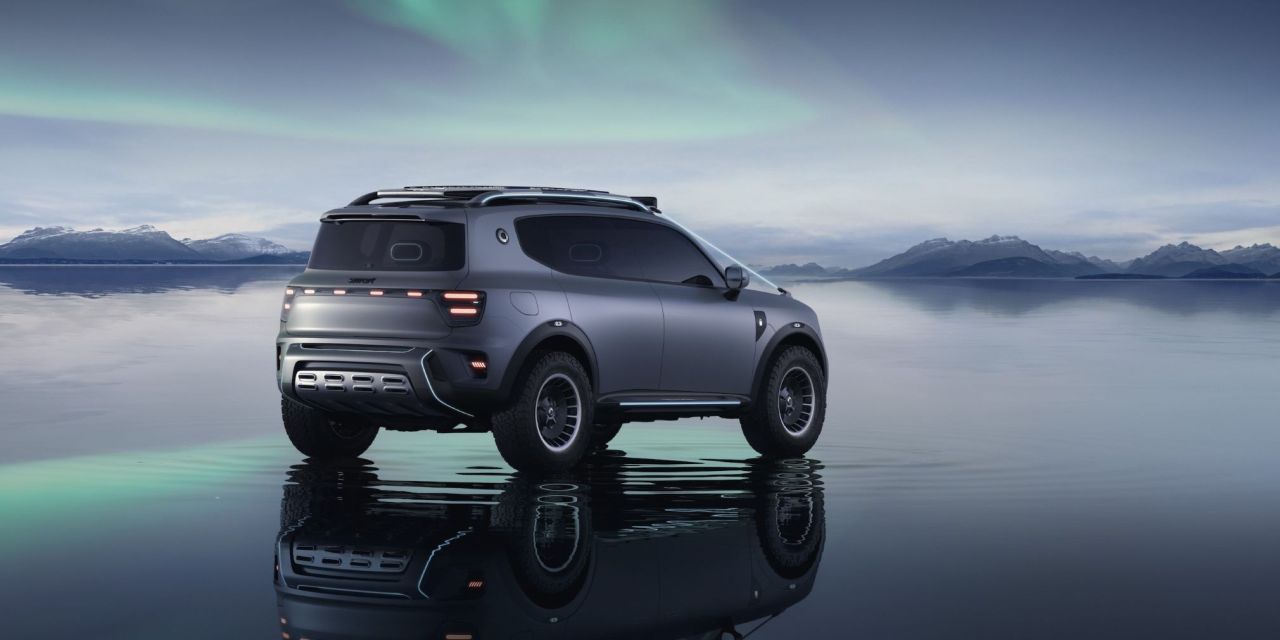After a four-year interval in the normally every-other-year cadence due to COVID, the eagerly anticipated Auto China took place from April 25th to May 4th in Beijing. While most other auto shows are in decline, the Beijing event was alive and more vibrant than the last event, mirroring the Chinese auto industry in the largest market. It has become an important biennial automotive industry showcase in China and globally, driving industry development and providing a crucial platform for technological innovation, especially in new energy and intelligent vehicles. This review highlights our favorite concepts from the event.
MG EXE181
- MG EXE181 render front side.
- MG EXE181 and EX181.
- MG EXE181 render rear side.
- MG EXE181 interior.
- MG EXE181 parachute braking.
MG‘s EXE181 electric concept supercar, shown at the 2024 Beijing International Auto Show, is meant to bridge MG’s past and future and conclude the Cyberster Global Journey across the Eurasian continent showcasing the new electric production roadster just launching onto the market. The team behind the design from SAIC Design Advanced London included Robert Lemmens, Gareth Culverhouse, David Harding, Maxime Gauthier, Oliver Freer-Ash, and Jonathon Allen.
The brand, now part of SAIC Motor Corp., has a history of speed, from its early success on racetracks and setting speed records in the 1920s and 1930s to the roadsters in the 1950s and 1960s. The legendary “Roaring Raindrop” MG EX181 set a speed record of 410.5 km/h in 1959, driven by Phil Hill, who became the first American F1 World Champion, holding in it until 2014 before being broken by Bugatti.
The launch of the electric EXE181 by MG’s London Advanced Design Center is a tribute to that effort and is said to mark a new chapter in the brand’s legacy. The engineers of the new concept aimed for a drag coefficient (Cd) of 0.181 for a top speed of 415 km/h (258 mph) and the “elite” sub-1-s 0-100 km/h club—to redefine acceleration and velocity in the electric era.
After Beijing, this electric supercar concept is planned for an appearance at the Goodwood Festival of Speed in July 2024.
JAC De-Fine
- JAC De-Fine front side.
- JAC De-Fine front.
- JAC De-Fine rear.
- JAC De-Fine ghost view.
- JAC De-Fine cockpit.
On the first anniversary of the release of JAC Group‘s “Guiding Intelligence with Intelligence” brand strategy, its new technology vision concept vehicle was unveiled. The De-Fine results from a continuous iteration around the brand’s new strategy since it entered the intelligent new energy field to transform and upgrade its market presence.
The company says that the sleek concept car features pioneering elements in its futuristic design, from integrated lights to coach doors. The four major technological bases integrated into the concept—high-performance intelligent architecture, cross-domain integration intelligent chassis, skyline intelligent cockpit, and high-order intelligent driving—support the advancement of JAC Group’s brand strategy.
With a new-generation high-performance intelligent architecture as the key technology base, the company’s vehicles will get “a smarter brain and nervous system with central computing + regional control + full-service technology.” It expects to build a “significant generational advantage” regarding chip arithmetic power, update speed, software and hardware service combination, and multi-dimensional security.
For the vehicle-level SOA (service-oriented architecture), JAC is adopting the layered development model of upper-layer application, middle-layer operating system, and bottom-layer hardware so that future products will provide custom functions and users can combine and define more than 100 application scenarios according to their preferences and needs to make vehicles “useful and fun.” The company’s self-developed vehicle-level FOTA (firmware over the air) program not only can upgrade the application software but also hardware functions such as driving, handling, and safety performance.
The company has also built a new-generation intelligent chassis with six-way active control through a high degree of integration between the power and chassis domains. The flexible and expandable design of the chassis enables electric and hybrid power options, rechargeable and exchangeable energy options, and two- and four-wheel drive. There are as many as 15 high-level active safety technologies, with redundant backups to ensure safety.
The car’s intelligent cockpit is based on Huawei’s Harmony OS to create a new-generation skyline intelligent cockpit with a panoramic screen, a center control intelligent screen, and an intelligent center island for a new human-vehicle interaction experience. The intelligent center island design integrates functions such as ambient lighting, sound effects, fragrance, and voice interaction, and creates scenarios such as campfire camping, immersive movie watching, interactive games, and lunchtime naps—allowing users to enjoy the third-space experience that combines static and motion.
JAC Group also partnered with Huawei and other leading technology companies to jointly develop and continue to build high-level intelligent driving capabilities, and fully enter the ADS 3.0 era.
Mazda Arata
- Mazda Arata front side.
- Mazda Arata front.
- Mazda Arata front.
- Mazda Arata rear side.
- Mazda Arata rear detail.
The Mazda EZ-6 is the first of a series of new electrified vehicles developed and manufactured by Changan Mazda in cooperation with Mazda and Changan Automobile) that will be launched in China by the end of 2024. The Mazda Arata concept previews the second scheduled to be mass-produced by the end of 2025 for the Chinese market.
“The Mazda EZ-6 is the latest electrified vehicle that combines Mazda’s strengths with Changan Automobile’s electrified technology,” Masahiro Moro, President & CEO of Mazda, said in the Changan Mazda press conference that took place today. “Going forward, Mazda will continue to work with Changan Automobile to turn Mazda’s China business around by introducing its unique products that meet the needs of Chinese customers who prefer advanced vehicles.
The Arata with its modern, refined styling, is designed to appeal to active, forward-looking Chinese customers.
“Arata means both ‘new’ and ‘creative,’ and the name represents our desire to build a new era for the Mazda brand,” said Moro. “Like the Mazda EZ-6, the new crossover SUV is scheduled for production in two powertrain versions, a BEV and a PHEV. We intend to introduce this model in 2025. Moreover, we have started studying the third and fourth NEV models.”
The Arata is a design concept model based on the Mazda philosophy of “uplifting the human spirit.” The crossover SUV is designed to appeal to the “advanced, sophisticated taste” of Chinese consumers. The design’s “soulful + futuristic x modern” theme fuses the “excitement of motion” pursued by Mazda Design and the sense of life unique to their overall Kodo design.
Design highlights include thick doors and rear combination lamps with their two “wings” overlapping each other to emphasize the new Mazda brand. Air tunnels are designed into the front hood edge, on both sides of the front bumper, and the inside of the D-pillars—for improved aerodynamic characteristics.
Volkswagen ID. Code
- VW ID. Code side.
- VW ID. Code front side.
- VW ID. Code rear side.
- VW ID. Code rear from above.
- VW ID. Code cockpit.
Volkswagen‘s similar “in China, for China” strategy is aimed at closer alignment with customer requirements in the world’s largest auto market and to provide them with a convincing product offering in all relevant segments. The sharpened strategy has three pillars: a comprehensive product portfolio accelerating the electrification of the brand’s models, a brand and design language developed specifically for the Chinese market, and local technical development with strong partners in China—like new partner Xpeng—to accelerate the pace of innovation.
The ID. Code design show car debuting at Auto China revealed the systematic re-orientation, the concept car’s aesthetics new and giving a preview of a large electric SUV designed for Level 4 autonomous driving. Also playing a key role in Volkswagen’s revamped profile in the Chinese market was news of a new progressive ID.UX sub-brand with all-electric, lifestyle-oriented models designed to appeal to younger customers in particular.
“The ID. Code gives a first preview of the future of VW in China: with a new design, a new technology standard, and a holistic brand experience—specifically oriented to the needs and wishes of our Chinese customers,” said Thomas Schäfer, CEO of the Volkswagen brand. “We are ushering in a new era of mobility in China, together with our Chinese partners.”
The ID. Code is the first preview of the new design language and technology for future cars, the concept developed specifically for customers in China. Said by VW to be reminiscent of a gran turismo, the vehicle’s fluid surfaces function as a projection surface for next-generation AI-assisted light and display systems. This is paired with the newly designed living space inside, where real and virtual worlds join to create a new mobility experience, whether the EV is driven conventionally or autonomously.
The ID. family will grow to a total of 16 models by 2030, including five EVs from the new ID.UX sub-brand that will celebrate their market debut by 2027. VW is introducing electric versions of its ICE models and expanding its portfolio in China with new, more efficient plug-in hybrids with an electric range of over 100 km (62 mi).
The automaker is complementing the MQB and MEB vehicle architectures with local platforms in China. One example is through the partnership with Xpeng, another by Volkswagen China Technology Company (VCTC) developing the VW Group’s first electric platform specifically for China. In collaboration with Xpeng, two new mid-class vehicles are planned from 2026. At least four additional models for the electric entry-level segment are to be built on the CMP (China Main Platform) from 2026.
The brand is also intensifying localization for significantly shorter development cycles, with Chinese partners such as Xpeng, Horizon Robotics, and Thundersoft to be integrated into the development process at an early stage. The Carizon joint venture with Horizon Robotics and the CarThunder joint venture with Thundersoft are engaged in developing systems for autonomous driving, infotainment, and connectivity.
Smart Concept #5
- Smart Concept #5 front side.
- Smart Concept #5 rear side.
- Smart Concept #5 interior roof.
- Smart Concept #5 interior.
With its Concept #5, the Smart brand introduces its most spacious and versatile vehicle to date, marking its entry into the premium mid-size SUV segment.
Combining an outdoor-inspired design with the brand’s functionality/approachability, the mid-size SUV features all-wheel drive, off-road tires, and state-of-the-art technology. The concept goes beyond urban boundaries to represent an evolutionary step for the premium brand founded in June 2020 as a joint venture between Mercedes-Benz AG and Geely Automobile Co., Ltd.
“The smart Concept #5 is the most unexpected and versatile car that our brand has ever created,” said Dirk Adelmann, CEO of Smart Europe GmbH. “With this vehicle, we leave all boundaries behind and open up a new segment for customers in Europe and worldwide.”
The concept hints at the series production model of the third vehicle in the Smart product portfolio planned for the second half of 2024.
The mid-size SUV concept has an efficient footprint, with overhangs at the front and rear being exceptionally short. The concept features a boxy, upright silhouette and distinctive X roof structure with protective front and rear skid plates, a hidden integrated winch, a folding rear step for roof access, and a roof light bar. Light animations offer a playful yet sophisticated touch.
The vehicle features a drive system with 800-V technology and a battery with a nominal capacity of 100+ kW·h and offers an all-electric WLTP range of more than 341 mi (550 km). Super-fast charging enables it to charge from 10% to 80% in just 15 min.
Tech highlights are five driving modes for different road conditions and an ADAS (advanced driving assistance system) solution that operates on both the highway and in urban environments.
Inside, the concept has maximized space, a wide console, “horizontally aligned” elements, and conveniently arranged interfaces for controls to ensure an organized feel and a pleasant user experience.
At the heart of the cabin is a new HMI (human-machine interface) layout on two OLED screens powered by the high-performance AMD V2000 chip. Ambient lighting and features such as a portable speaker integrated into the center console add to the charm. The zero-gravity front passenger seat integrates comfort features like heating, ventilation, massage, leg rest, and new airbag solutions.
A key feature of the generative AI specialist Cerence enables the driver and passengers to engage the virtual in-car assistant in entertaining conversations. It uses intelligent in-vehicle interaction technologies to provide accurate and relevant answers to almost any question imaginable.
Users can voice-control key functions including phone calls and messages, music and media, air conditioning, navigation, personal settings, and vehicle control—as well as access information such as weather, news, calendars, and general knowledge.







































































































































